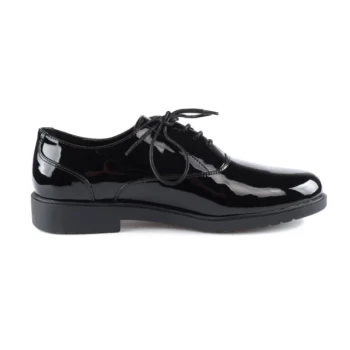The outsole tread in slip-resistant shoes plays a crucial role in preventing slips and falls by enhancing grip on slippery surfaces. Its design, material, and thickness work together to displace liquids like water or oil, rather than trapping them underneath the shoe. This is achieved through specialized patterns (e.g., hexagonal or circular grooves) and soft rubber materials that maximize friction. The tread's ability to channel liquids away ensures consistent contact with the ground, improving stability and safety in wet or oily environments.
Key Points Explained:
-
Liquid Displacement Mechanism
- The tread pattern (hexagonal, circular, or other designs) creates grooves that allow liquids (water, oil, etc.) to flow away from the contact area.
- By preventing liquid buildup under the sole, the shoe maintains direct contact with the floor, reducing hydroplaning effects.
- This is especially critical in environments like kitchens, hospitals, or industrial workplaces where spills are common.
-
Enhanced Friction Through Material and Design
- Slip-resistant outsoles are typically made of soft rubber, which provides higher friction against smooth or contaminated surfaces.
- The tread's surface area and depth are optimized to increase grip without compromising flexibility or comfort.
- Thicker outsoles often correlate with better traction, as they offer more material to deform and adapt to surface irregularities.
-
Pattern-Specific Performance
- Hexagonal patterns: Distribute pressure evenly and create multiple edges for micro-grip.
- Circular patterns: Allow multidirectional liquid displacement, useful for dynamic movements.
- Groove width and depth are calibrated to balance debris clearance and surface contact.
-
Application in Hazardous Environments
- Effective against water, oil, food residues, and ice—common hazards in workplaces like restaurants or factories.
- Reduces workplace injuries by up to 50% in high-risk settings, according to occupational safety studies.
-
Durability and Maintenance Considerations
- Tread depth wears over time; regular inspection ensures ongoing slip resistance.
- Softer rubber compounds may wear faster but provide superior grip compared to hard, rigid soles.
-
Scientific Principle Behind the Design
- Based on tribology (the study of friction), the tread minimizes the lubricating effect of liquids by breaking surface tension.
- The "stick-slip" phenomenon is mitigated through continuous contact points.
Would thicker treads always outperform thinner ones, or are there trade-offs in flexibility and weight? The answer lies in the specific use case—for instance, healthcare workers might prioritize lightweight designs for mobility, while kitchen staff benefit from deeper grooves for heavy spill resistance.
Summary Table:
| Feature | Function |
|---|---|
| Tread Pattern | Hexagonal/circular grooves channel liquids away, preventing hydroplaning. |
| Material | Soft rubber increases friction and adapts to surface irregularities. |
| Tread Depth | Deeper grooves enhance spill resistance; thinner designs prioritize weight. |
| Applications | Ideal for kitchens, hospitals, and industrial workplaces with frequent spills. |
| Durability | Softer rubber wears faster but maintains superior grip over time. |
Upgrade your workforce’s safety with 3515’s high-performance slip-resistant footwear! As a leading manufacturer, we specialize in durable, scientifically designed shoes tailored for demanding environments—whether you’re a distributor, brand owner, or bulk buyer. Our outsoles combine advanced tread patterns and premium materials to reduce workplace injuries by up to 50%. Get a customized quote today and equip your team with footwear that prioritizes both safety and comfort!
Related Products
- Durable Leather Moc Toe Work Boots for Wholesale & Custom Manufacturing
- Durable Moc-Toe Wedge Work Boots | Wholesale Manufacturing for Brands
- Wholesale Durable Safety Boots | Custom Steel Toe & Puncture-Resistant Manufacturing
- Custom Wholesale Leather Safety Boots Direct Factory Manufacturing
- Safety Footwear Wholesale Manufacturer for Custom OEM/ODM Production
People Also Ask
- What are some methods to make regular shoes more slip-resistant? Enhance Safety with Simple Solutions
- Why are slip-resistant soles important in work boots? Essential Safety for Hazardous Work Environments
- How do slip-resistant boots enhance workplace safety? Boost Traction & Reduce Injuries
- What is the significance of slip resistance in work shoes? Essential Safety for Hazardous Environments
- What types of jobs are wedge sole work boots suitable for? Ideal Footwear for Flat Surface Work

















